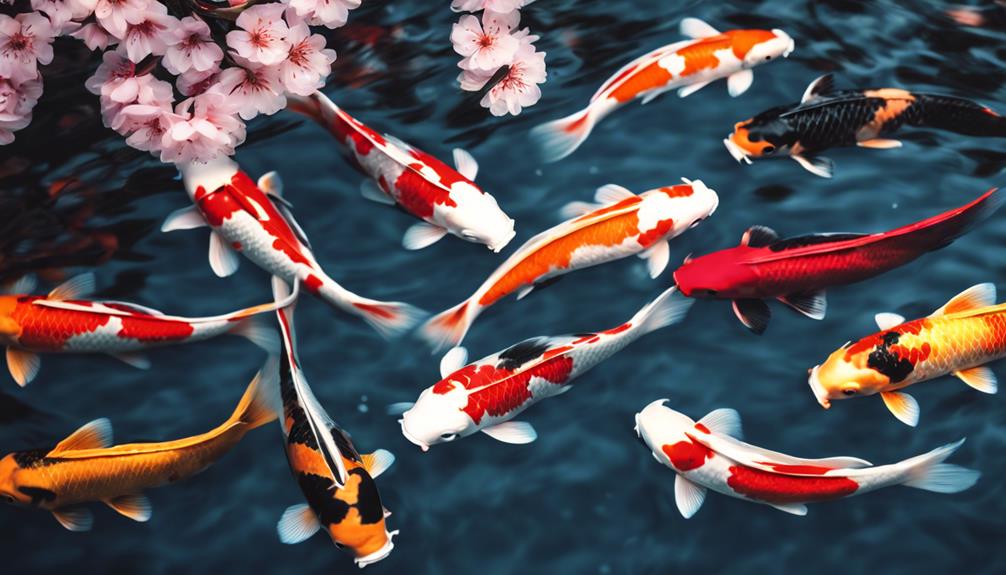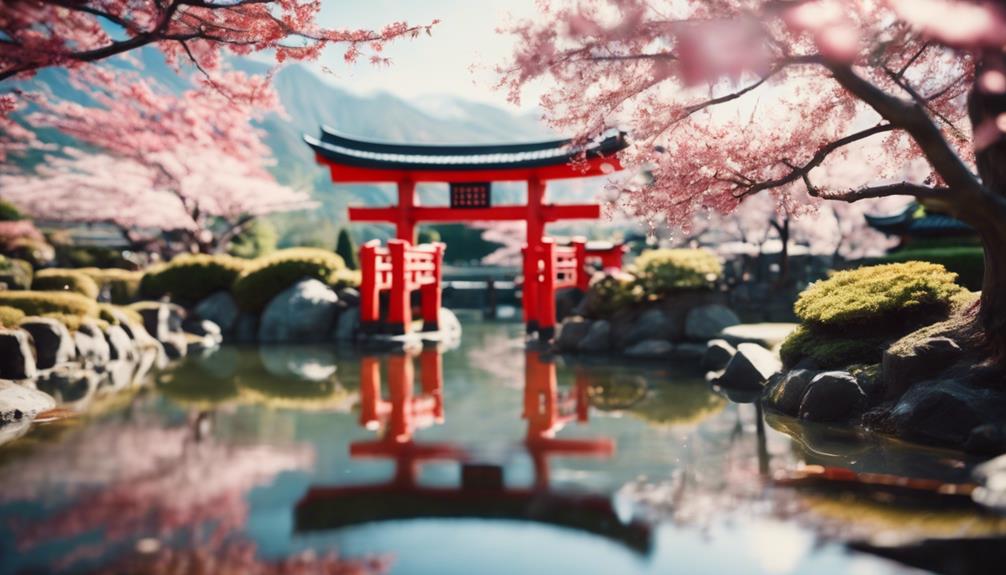Japanese symbols hold deep cultural significance. The ☆ symbol shines bright in family crests, bringing joy. Cherry blossoms show life's fleeting beauty. The Koi fish stands for luck and resilience with its bright colors. Torii gates mark sacred spots, full of history. The Maneki-Neko brings good fortune and wealth, part of Japanese tradition. These symbols mirror Japan's rich heritage and values, giving a peek into its rich traditions. Each symbol tells a unique tale, showing the depth of Japanese artistry and storytelling. They represent values deeply treasured in Japanese society.
Key Takeaways
- The ☆ Symbol: Represents cultural importance, seen in family crests, titles, and characters' traits, adding cheerfulness.
- Cherry Blossom: Symbolizes life's fragility, impermanence, and beauty in transience, embodying Japanese philosophy.
- Koi Fish: Symbolizes determination, luck, and resilience, with vibrant colors carrying specific meanings.
- Torii Gate: Marks the threshold between ordinary and sacred, found at Shinto shrines, warding off evil spirits.
- Maneki-Neko: Beckoning cat attracting good luck and prosperity, with different colors symbolizing various meanings, rooted in Japanese culture.
The ☆ Symbol
The ☆ symbol holds significant cultural importance in Japanese storytelling and artistic expression. In Japan, symbols like the ☆ are deeply ingrained in the culture, often carrying layers of meaning beyond their visual representation. The ☆ symbol is commonly seen in Japanese family crests, known as 'kamon,' which are emblems used to identify a family lineage or clan. These crests can be found on various objects like clothing, armor, and flags, serving as a symbol of pride and heritage.
In addition to family crests, the ☆ symbol is frequently used in titles of songs, works of art, groups, and pseudonyms. Its stylish version of the ・symbol adds a cheerful and outgoing atmosphere to any context where it's employed. This symbol can also be used as a visual divider in different settings to enhance the overall aesthetic appeal. Furthermore, in Japanese storytelling, the ☆ symbol is often utilized in characters' lines to represent traits like sunshine, kawaii, or innocence, infusing a sense of cheerfulness or airheadedness into the narrative.
The Cherry Blossom

Celebrating the ephemeral beauty of nature, cherry blossoms hold a revered place in Japanese culture. These delicate flowers, symbols of Japan, encapsulate the country's cultural heritage and aesthetic appeal. Annually during the cherry blossom season, known as Hanami, people gather to admire the fleeting beauty of these blooms. The cherry blossom's significance goes beyond its visual appeal; it symbolizes life's fragility and the transient nature of existence. Depicted in various art forms like vases and paintings, cherry blossoms represent the fleeting beauty of the spring season.
In Japanese symbolism, the cherry blossom serves as a powerful reminder of the impermanence of life and the beauty found in transience. This profound reflection on the cycle of life has deeply ingrained the cherry blossom as a cherished motif in Japanese art, literature, and cultural practices. The delicate yet vibrant nature of these flowers captures the essence of the Japanese philosophy, embodying simplicity, impermanence, and appreciation of the present moment.
The Koi Fish

Admired for its representation of perseverance and good fortune, the Koi fish holds a prominent place in Japanese culture. Here are some fascinating facts about the Koi fish:
- Symbolism: The Koi fish symbolizes traits like determination, luck, and resilience in Japanese history, reflecting values highly esteemed in society.
- Color Meanings: Vibrant colors of Koi fish carry specific symbolism; for instance, red symbolizes love, while gold represents wealth and prosperity, adding depth to the symbolism.
- Dragon Gate Legend: The Koi fish is linked to the tale of the Dragon Gate, where it transforms into a dragon after overcoming obstacles, embodying the idea of transformation and achievement.
- Art and Gardens: Koi fish are prevalent in Japanese art and are featured in ponds in gardens, symbolizing harmony, balance, and prosperity, enriching the cultural tapestry with their presence.
The Torii Gate

As we step into the domain of Japanese culture, the Torii Gate stands as a traditional symbol marking the threshold between the ordinary and the sacred. This iconic gate is commonly seen at the entrance of Shinto shrines, serving as a powerful symbol of shift from the mundane to the spiritual sphere.
The Torii Gate's design, with two vertical pillars supporting a horizontal crossbar, represents the shift from the profane to the sacred space within the shrine precincts. The vibrant vermilion color of the gate is believed to ward off evil spirits and bestow good fortune upon those who pass through it.
During the Edo period, the Torii Gate held significant importance for feudal lords, signifying their connection to the spiritual world and their authority within their dominion. The gate's presence was a clear indication of the sacredness of the shrine grounds and the reverence with which visitors should approach the shrine. The Torii Gate continues to be a revered symbol in Japanese culture, embodying the rich spiritual traditions and beliefs of the country.
The Maneki-Neko

Stepping further into Japanese symbolism, the Maneki-Neko, also known as the beckoning cat, emerges as a prevalent talisman believed to attract good luck and prosperity.
The Maneki-Neko, with its one paw raised in a beckoning gesture, is a common sight in Japanese homes and businesses, symbolizing the invitation of wealth and customers.
Different colors of the Maneki-Neko carry various meanings; white for purity, black for safety, and gold for prosperity.
The raised paw of the Maneki-Neko is thought to bring good fortune and opportunities to the owner, enhancing their luck and success.
This iconic symbol is deeply rooted in Japanese culture, embodying the wish for abundance and positivity.
The Maneki-Neko's popularity transcends borders, captivating the hearts of many with its charm and auspicious aura. Its presence in Japanese society signifies a longstanding tradition of beckoning good luck and fortune, a sentiment cherished by emperors and commoners alike throughout history.
Frequently Asked Questions
What Is the Most Powerful Symbol in Japan?
The most powerful symbol in Japan is the sixteen petal chrysanthemum. It represents imperial virtues and is prominently featured on Shinto shrines.
This crest, along with the Three Sacred Treasures of Japan, holds immense cultural significance. These mythical objects, including a sacred sword, mirror, and jewel, are deeply rooted in Japan's imperial history and traditions.
The chrysanthemum crest symbolizes the enduring legacy of the Japanese emperor.
What Are the Sacred Symbols of Japan?
We'll explore the sacred symbols of Japan, highlighting their deep cultural and historical significance.
From the majestic chrysanthemum crest symbolizing imperial authority to the Three Sacred Treasures embodying virtues and mythical importance, these symbols connect to Japan's rich heritage.
Each emblem holds a unique story, bridging the past with the present, showcasing the essence of Japan's imperial and spiritual legacy.
What Are the 3 National Symbols of Japan?
We'll discuss the 3 national symbols of Japan: the chrysanthemum crest, the Three Sacred Treasures, and the Japanese flag.
The chrysanthemum crest represents the Japanese emperor and adorns Shinto shrines.
The Three Sacred Treasures symbolize imperial virtues and include a sacred sword, mirror, and jewel.
The Japanese flag, Hinomaru, features a red circle representing the rising sun and became the national flag in 1870.
What Is Japan Iconic Symbol?
We believe that the iconic symbol of Japan is the sixteen petal chrysanthemum. This emblem, representing imperial virtues, is deeply ingrained in Japan's culture and history.
Adorning Shinto shrines and embodying the imperial lineage, the chrysanthemum crest is a powerful emblem of Japan's imperial and state symbols. It holds significant cultural importance and symbolizes the rich heritage of the Japanese people.
What Is the Symbolic Meaning Behind Japanese Symbols and How Do They Compare to Confirmation Names?
Japanese symbols hold deep cultural and spiritual significance. From the iconic cherry blossom to the powerful dragon, each symbol carries its own unique meaning. Similarly, confirmation names hold symbolic value in Christian tradition, signifying a personal connection to a saint or virtue. Explore our meaningful confirmation names list for inspiration.
Conclusion
To sum up, these five Japanese symbols hold deep meanings and cultural significance. From the serene cherry blossom to the auspicious maneki-neko, each symbol tells a unique story.
It's fascinating how a simple image can carry such rich symbolism and history. Who knew that a koi fish could represent perseverance, or that a torii gate could symbolize a gateway between the physical and spiritual worlds?
The beauty of these symbols lies in their hidden depths, waiting to be explored.










